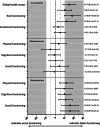The association between changes in muscle mass and quality of life in patients with metastatic colorectal cancer
- PMID: 32107889
- PMCID: PMC7432557
- DOI: 10.1002/jcsm.12562
The association between changes in muscle mass and quality of life in patients with metastatic colorectal cancer
Abstract
Background: Skeletal muscle mass (SMM) loss is common in metastatic colorectal cancer (mCRC) patients and associated with poor clinical outcomes, including increased treatment-related toxicities and reduced survival. Muscle loss may contribute to reduced health-related quality of life (HRQoL), including fatigue. Our aim was to study associations between changes in SMM and concomitant changes in patient-reported HRQoL.
Methods: This was a secondary analysis of mCRC patients in the CAIRO3 randomized clinical trial who were-after initial treatment-randomized between maintenance treatment with capecitabine plus bevacizumab (CAP-B) and observation until first disease progression (PD1). Included patients had computed tomography images for SMM quantification, together with HRQoL assessments available at randomization and PD1. Changes in SMM (categorized as >2% loss, stable, and >2% gain) and HRQoL were computed between randomization and PD1. Changes in HRQoL score >10 points were considered clinically relevant. Associations between SMM and HRQoL changes were studied by multiple linear regression models. We also investigated whether associations differed by treatment arm for global health and the 13 other HRQoL subscales.
Results: Of 221 patients included (mean age 63.5 ± 8.4 years), 24% lost, 27% remained stable, and 49% gained SMM. At randomization, mean global health status was 73.5 ± 15.9 in the CAP-B arm and 75.1 ± 17.5 in the observation arm (P = 0.48). A stable or gain in SMM was significantly associated with a clinically relevant improvement in global health status (9.9 and 14.7 points, respectively), compared with patients who lost SMM. From the subscales that did not show significant differences between the two treatment arms, we found significant and clinically relevant associations for stable or gain in SMM with improved role functioning (12.0 and 17.9, respectively) and with less fatigue (-10.0 and -15.0, respectively) and pain (-16.3 for SMM gain). From the subscales that did show significantly different associations with SMM between the two treatment arms, we only found significant results in the observation arm. Here, associations were found for stable or gain in SMM with clinically relevant improved physical (12.4 for SMM gain), cognitive (10.7 and 9.7, respectively), and social functioning (15.5 and 15.6, respectively) as well as reduced appetite loss (-28.5 and -30.7, respectively).
Conclusions: In mCRC, SMM preservation during CAP-B and observation treatment is associated with significant and clinically relevant improvements in global health status and multiple functional and symptom scales. Studies are warranted to investigate whether interventions targeting SMM lead to improved HRQoL, fewer symptoms, and better functioning.
Keywords: Metastatic colorectal cancer; Quality of life; Skeletal muscle mass; Supportive care.
© 2020 The Authors. Journal of Cachexia, Sarcopenia and Muscle published by John Wiley & Sons Ltd on behalf of Society on Sarcopenia, Cachexia and Wasting Disorders.
Conflict of interest statement
B.D. and M.J. work at Nutricia Research. All other authors declare that they have no conflict of interest.
Figures



References
-
- van Gestel YR, de Hingh IH, van Herk‐Sukel MP, van Erning FN, Beerepoot LV, Wijsman JH, et al. Patterns of metachronous metastases after curative treatment of colorectal cancer. Cancer Epidemiol 2014;38:448–454. - PubMed
-
- van der Geest LG, Lam‐Boer J, Koopman M, Verhoef C, Elferink MA, de Wilt JH. Nationwide trends in incidence, treatment and survival of colorectal cancer patients with synchronous metastases. Clin Exp Metastasis 2015;32:457–465. - PubMed
-
- Fearon K, Strasser F, Anker SD, Bosaeus I, Bruera E, Fainsinger RL, et al. Definition and classification of cancer cachexia: an international consensus. Lancet Oncol 2011;12:489–495. - PubMed
-
- Baracos VE, Martin L, Korc M, Guttridge DC, Fearon KCH. Cancer‐associated cachexia. Nat Rev Dis Primers 2018;4:Article number:17105. - PubMed
Publication types
MeSH terms
LinkOut - more resources
Full Text Sources
Medical
Miscellaneous

